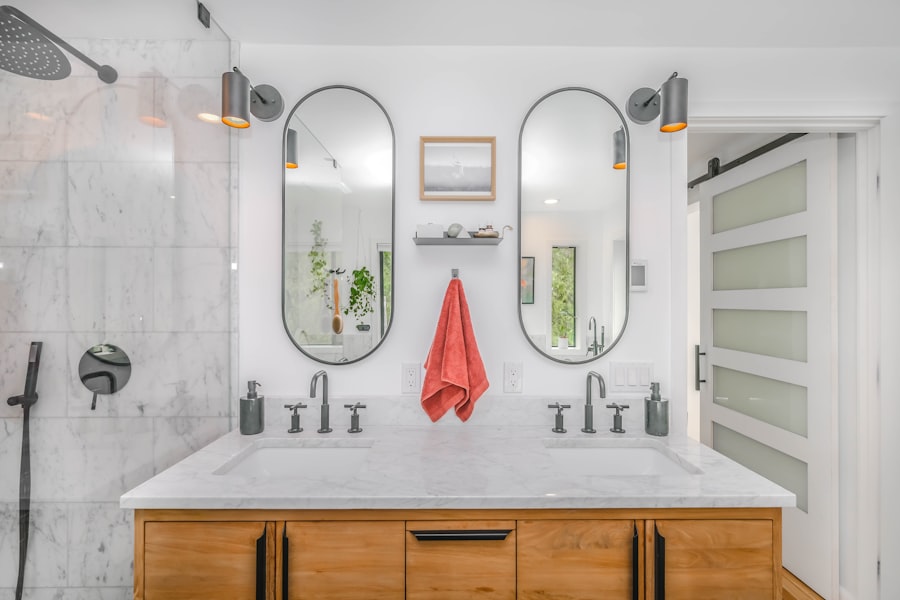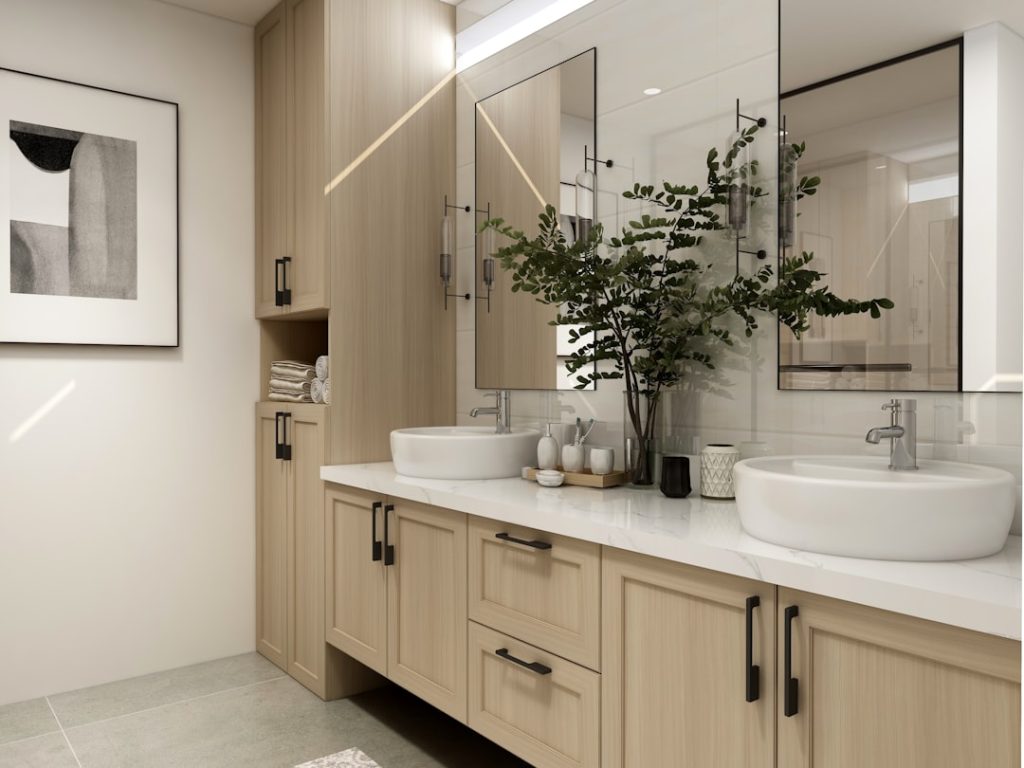A custom vanity serves as more than just a functional piece of furniture; it is a statement of personal style and an integral component of bathroom design. One of the primary benefits of a custom vanity is the ability to tailor it to your specific needs and preferences. Unlike pre-fabricated options, which often come in standard sizes and styles, a custom vanity can be designed to fit the unique dimensions of your space.
This means that you can maximize every inch of your bathroom, ensuring that even the smallest areas are utilized effectively. For instance, if you have an oddly shaped bathroom or limited square footage, a custom vanity can be crafted to fit snugly into the available space, providing both functionality and aesthetic appeal. Moreover, a custom vanity allows for greater personalization in terms of design elements.
Homeowners can choose everything from the style of cabinetry to the type of countertop, ensuring that the final product reflects their individual taste. This level of customization can enhance the overall ambiance of the bathroom, making it a more inviting and enjoyable space. For example, if you prefer a modern aesthetic, you might opt for sleek lines and minimalist hardware, while those who favor a more traditional look could select ornate details and rich wood finishes.
The ability to curate these elements not only elevates the visual appeal but also contributes to a cohesive design throughout the home.
Key Takeaways
- Custom vanities offer tailored benefits that enhance both functionality and style in your bathroom.
- Designing your vanity to fit the specific dimensions of your space maximizes usability and aesthetics.
- Selecting appropriate materials ensures durability and complements your bathroom’s overall design.
- Integrating smart storage solutions helps keep your bathroom organized and clutter-free.
- Professional installation and regular maintenance are key to preserving the quality and longevity of your custom vanity.
Designing Your Custom Vanity to Fit Your Space
When embarking on the journey of designing a custom vanity, the first step is to assess the dimensions and layout of your bathroom. Accurate measurements are crucial; they will dictate not only the size of the vanity but also its placement within the room. For instance, if your bathroom features a double sink setup, you will need to ensure that there is adequate space for both sinks as well as counter space on either side.
Additionally, considering the flow of movement within the bathroom is essential. A well-placed vanity should allow for easy access to other fixtures such as the shower or toilet without creating congestion. Incorporating design elements that complement your existing decor is another vital aspect of creating a custom vanity.
This could involve selecting colors that harmonize with your wall paint or tiles, or choosing hardware that matches other fixtures in the room. For example, if your bathroom has a coastal theme, you might choose a light blue or white finish for your vanity, paired with brushed nickel hardware that evokes a nautical feel. Furthermore, considering the height of the vanity is important; standard vanities are typically around 30 to 32 inches tall, but taller individuals may prefer a higher countertop to enhance comfort during use.
Choosing the Right Materials for Your Custom Vanity

The selection of materials for your custom vanity plays a significant role in both its durability and aesthetic appeal. When it comes to cabinetry, hardwoods such as oak, maple, or cherry are popular choices due to their strength and longevity. These materials can withstand the humid environment of a bathroom while providing a classic look that can be stained or painted to match your design vision.
Alternatively, engineered woods like plywood or MDF (medium-density fiberboard) offer cost-effective options that can still deliver impressive results when finished properly. Countertops are another critical consideration in material selection. Natural stone options like granite or marble are favored for their beauty and resilience; however, they require regular sealing to prevent staining and damage from moisture.
Quartz countertops have gained popularity as an alternative due to their non-porous nature and wide range of colors and patterns available. For those seeking a more budget-friendly option, laminate surfaces can mimic the appearance of stone while being easier to maintain. Ultimately, the choice of materials should align with both your functional needs and aesthetic preferences, ensuring that your custom vanity remains both beautiful and practical over time.
Incorporating Storage Solutions into Your Custom Vanity
| Storage Solution | Average Capacity | Space Utilization | Cost Efficiency | Ease of Installation | Maintenance Level |
|---|---|---|---|---|---|
| Drawers | 15-25 liters | High | Moderate | Easy | Low |
| Open Shelves | 20-30 liters | Moderate | High | Very Easy | Low |
| Cabinet Doors | 30-50 liters | High | Moderate | Moderate | Moderate |
| Pull-out Baskets | 10-20 liters | High | Low | Moderate | Moderate |
| Built-in Hampers | 40-60 liters | High | Moderate | Moderate | Low |
Effective storage solutions are essential in any bathroom, and a custom vanity provides an excellent opportunity to integrate these features seamlessly into your design. One popular approach is to include drawers of varying sizes to accommodate different items. For instance, shallow drawers can be perfect for storing cosmetics and toiletries, while deeper drawers can hold larger items such as towels or hair dryers.
Additionally, incorporating dividers within drawers can help keep smaller items organized and easily accessible. Open shelving is another storage solution that can add both functionality and style to your custom vanity. This design element allows for easy access to frequently used items while also providing an opportunity to display decorative elements such as plants or decorative baskets.
For example, if you have a collection of beautiful towels or artisanal soaps, open shelving can showcase these items while keeping them within reach. Furthermore, consider adding cabinets with doors for concealed storage; this can help maintain a clean and uncluttered appearance in your bathroom while still providing ample space for all your essentials.
Adding Personalized Touches to Your Custom Vanity
Personalization is what truly sets a custom vanity apart from standard options available on the market. Adding unique touches can transform an ordinary piece into something that feels distinctly yours. One way to achieve this is through hardware selection; knobs and pulls come in an array of styles, materials, and finishes that can dramatically alter the look of your vanity.
For instance, vintage-inspired brass hardware can evoke a sense of nostalgia, while sleek chrome fixtures may lend a contemporary edge. Incorporating decorative elements such as mirrors or lighting fixtures can also enhance the overall aesthetic of your custom vanity. A statement mirror with an ornate frame can serve as a focal point in the room, while strategically placed sconces or pendant lights can provide both illumination and style.
Additionally, consider integrating personal items into your design—perhaps a framed photo or a piece of art that resonates with you—creating a space that feels uniquely tailored to your personality and lifestyle.
Hiring a Professional to Install Your Custom Vanity

While some homeowners may feel confident in their DIY skills, hiring a professional for the installation of your custom vanity can ensure that the job is done correctly and efficiently. Professionals bring expertise and experience that can be invaluable when it comes to complex installations involving plumbing or electrical work. For example, if your custom vanity includes integrated lighting or requires adjustments to existing plumbing for sinks, having a qualified contractor handle these tasks can prevent potential issues down the line.
Moreover, professionals can provide insights into design considerations that may not be immediately apparent to homeowners. They may suggest optimal placement based on traffic flow or recommend specific materials that will work best in your bathroom’s environment. By collaborating with an expert, you not only save time but also gain peace of mind knowing that your investment is being handled with care and precision.
Maintaining and Caring for Your Custom Vanity
Once your custom vanity is installed, ongoing maintenance is key to preserving its beauty and functionality over time. Regular cleaning is essential; using gentle cleansers that are appropriate for the materials used will help prevent damage while keeping surfaces looking fresh. For instance, natural stone countertops should be cleaned with pH-balanced cleaners to avoid etching or dulling their finish.
Additionally, it’s important to promptly address any spills or stains to prevent them from setting in. Beyond cleaning, periodic inspections are advisable to ensure that all components remain in good working order. Check for any signs of wear or damage, particularly in areas prone to moisture exposure such as around sinks or faucets.
If you notice any issues—such as water damage or loose hardware—addressing them quickly can prevent more significant problems from developing in the future.
Budgeting for Your Custom Vanity Upgrade
Budgeting for a custom vanity upgrade requires careful planning and consideration of various factors that contribute to overall costs. The price range for custom vanities can vary widely based on materials chosen, size, complexity of design, and additional features such as integrated lighting or specialized storage solutions. It’s essential to establish a clear budget before beginning the design process; this will help guide decisions regarding materials and features without overspending.
When creating your budget, consider not only the initial costs but also potential long-term expenses associated with maintenance and repairs. Investing in high-quality materials may result in higher upfront costs but can lead to savings over time due to increased durability and reduced need for replacements or repairs. Additionally, setting aside funds for professional installation ensures that you achieve the best possible results without compromising on quality due to DIY efforts that may not meet professional standards.
By understanding these various aspects—from design considerations to material choices—you can create a custom vanity that not only enhances your bathroom’s functionality but also reflects your personal style and meets your specific needs.



